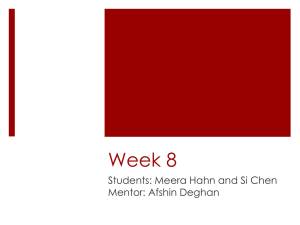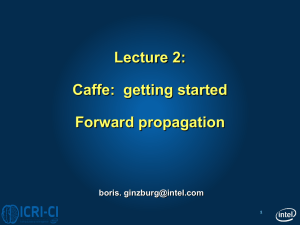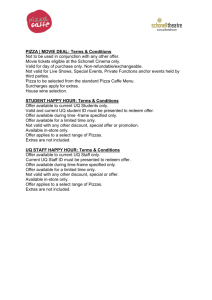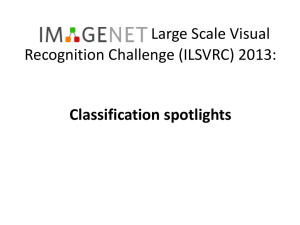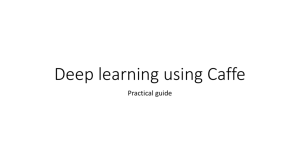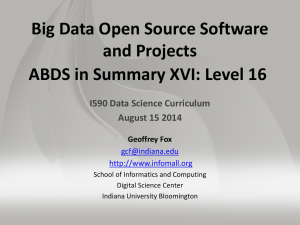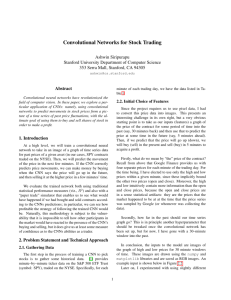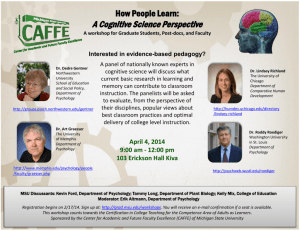Webinar Question Webinar Response can you use only part of the
advertisement
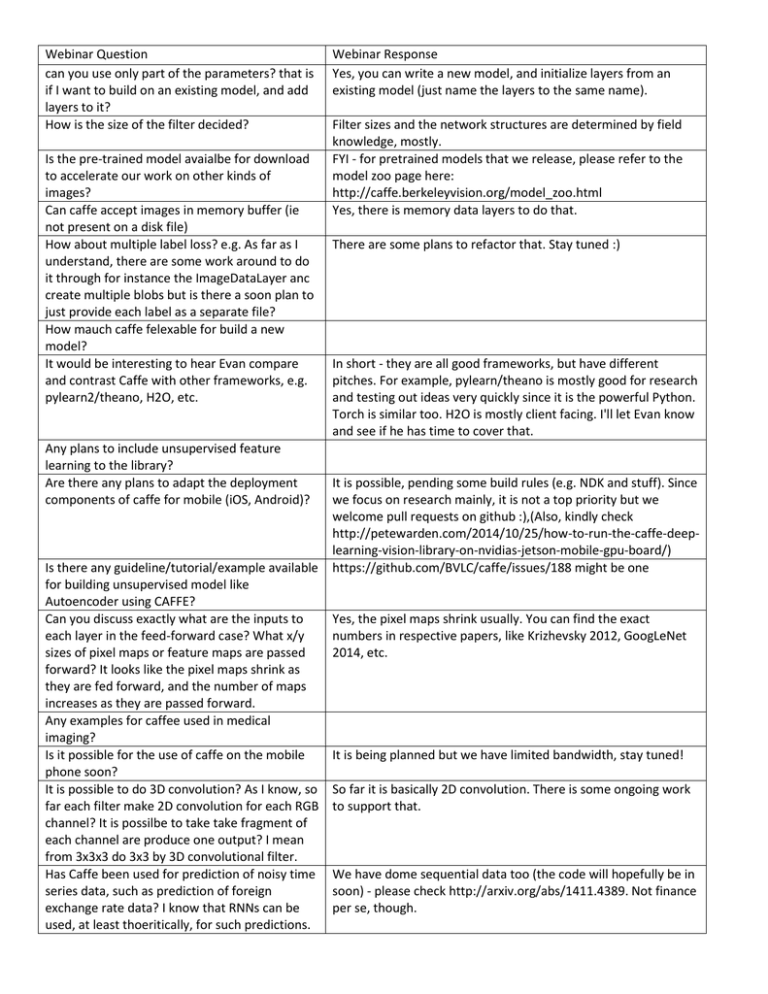
Webinar Question can you use only part of the parameters? that is if I want to build on an existing model, and add layers to it? How is the size of the filter decided? Is the pre-trained model avaialbe for download to accelerate our work on other kinds of images? Can caffe accept images in memory buffer (ie not present on a disk file) How about multiple label loss? e.g. As far as I understand, there are some work around to do it through for instance the ImageDataLayer anc create multiple blobs but is there a soon plan to just provide each label as a separate file? How mauch caffe felexable for build a new model? It would be interesting to hear Evan compare and contrast Caffe with other frameworks, e.g. pylearn2/theano, H2O, etc. Any plans to include unsupervised feature learning to the library? Are there any plans to adapt the deployment components of caffe for mobile (iOS, Android)? Is there any guideline/tutorial/example available for building unsupervised model like Autoencoder using CAFFE? Can you discuss exactly what are the inputs to each layer in the feed-forward case? What x/y sizes of pixel maps or feature maps are passed forward? It looks like the pixel maps shrink as they are fed forward, and the number of maps increases as they are passed forward. Any examples for caffee used in medical imaging? Is it possible for the use of caffe on the mobile phone soon? It is possible to do 3D convolution? As I know, so far each filter make 2D convolution for each RGB channel? It is possilbe to take take fragment of each channel are produce one output? I mean from 3x3x3 do 3x3 by 3D convolutional filter. Has Caffe been used for prediction of noisy time series data, such as prediction of foreign exchange rate data? I know that RNNs can be used, at least thoeritically, for such predictions. Webinar Response Yes, you can write a new model, and initialize layers from an existing model (just name the layers to the same name). Filter sizes and the network structures are determined by field knowledge, mostly. FYI - for pretrained models that we release, please refer to the model zoo page here: http://caffe.berkeleyvision.org/model_zoo.html Yes, there is memory data layers to do that. There are some plans to refactor that. Stay tuned :) In short - they are all good frameworks, but have different pitches. For example, pylearn/theano is mostly good for research and testing out ideas very quickly since it is the powerful Python. Torch is similar too. H2O is mostly client facing. I'll let Evan know and see if he has time to cover that. It is possible, pending some build rules (e.g. NDK and stuff). Since we focus on research mainly, it is not a top priority but we welcome pull requests on github :),(Also, kindly check http://petewarden.com/2014/10/25/how-to-run-the-caffe-deeplearning-vision-library-on-nvidias-jetson-mobile-gpu-board/) https://github.com/BVLC/caffe/issues/188 might be one Yes, the pixel maps shrink usually. You can find the exact numbers in respective papers, like Krizhevsky 2012, GoogLeNet 2014, etc. It is being planned but we have limited bandwidth, stay tuned! So far it is basically 2D convolution. There is some ongoing work to support that. We have dome sequential data too (the code will hopefully be in soon) - please check http://arxiv.org/abs/1411.4389. Not finance per se, though. I wanna recocgnize words in text... what is the best model can i use with caffe? can i use caffe with windows 8 ? Off Topic question: which tool do you use to draw your operation flow diagrams, they look very elegant! Can you discuss status and/or considerations for adding opencl support (and so be vendor neutral, as opposed to NVIDIA CUDA)? Does caffe support (or plan to) datasets other than images? I.e. a 1d vector for example. How do you characterize the training complexity vs. the run-time classification complexity? (The timing example that was given - I guess that was for classification? how does caffe handle large models vs the number of GPU cores available? does it partition the GPU computations or is there a size point where it gives up and rolls back to CPU-only computation? What is the precise definition of an "iteration" during training? Does that mean backpropogation has occured once for everything in the blob? I see you're working on adding GMM support. Will you enable parameters intialization using GMM is input? Can you please send the references (e.g. [Chopra05]) to papers together with the slide presentation? is it possible to use shared weights as tied weights for denoising autoencoders as mentioned here http://tinyurl.com/lw2mzsb I want to contribute to the project, where should I start? Did Evan say at start that the licence on pretrained models is changing? Or what that was about ? Thanks! Hello. Thanks for this presentation. How did you visualize the features (low-level, and high-level) since they are high-dimensional? so is the top of one layer the bottom of the next layer? is that how the data is actually passed? can I use caffe to do neural network in fraud detection in financial application? Is it easy to use adaptive learning rate algorithms such as vSGD and AdaDelta with Caffe? I don't think we have done text recognition models, but there are some papers on that, which may help creating such models. Ah, pydot + graphviz is the tool. In terms of using OpenCL - it has been under discussion for a while, but we are kind of shortstaffed so we focus more on the research side - we welcome contributions from open-source communities of course, please join us at github :) Yes, Evan will talk about the data structure shortly I think, and for 1d vectors, you can set the data height and width to 1. All layers can be used (of course convolution and pooling type layers will not be applied here) For classification, usually training takes about 3 times longer per image. E.g. for AlexNet, forward and backward together is about 6-7ms, while forward only is about 2ms It currently requires one to fit models into the GPU memory - but with larger GPUs like 6G and 12G memory, it seems less of an issue. Iteration means doing one forward and backward pass on a batch - as in the conventional SGD context. Sorry, do you mean Gaussian Mixture Model for GMM? Yes. There will be a slide listing the references at the end of the slides. Yes, there is a way to share the weights between layers. See http://caffe.berkeleyvision.org/gathered/examples/siamese.html Yes, they are now fully open (no non-commercial constraints) We used T-SNE to embed the features (for example, fc6 has 4096 dimensions) to a 2-dimensional space. T-SNE is known to preserve local structures and shows the embedding. Dots are colored with their ground-truth labels. Yes. In principle yes, but that also depends on your data and a bit field knowledge is needed. We don't have that yet, but examples of existing solvers may help you implement one. Please, from where do we can download Caffe code ? In addition, are there any tutorials for the code so can follow or study ? Is there/will there be option to try new/different learning methods, say a a different variant of back prop Thanks for the great talk. Can you comment on how to choose learning rate policy and lr parameters such as momentum, decay, lr factors for bias and weights etc more systematically instead of brute force? What HW/SW platforms are supported? does caffe have a dropout unit ? any multi-modal model of images and caption text? Does "pythonification" here mean the net runs slower because its python? It would be interesting to hear how flexible Caffe is for tasks other than images/vision. Could you solve the GoogLeNet "vanishing gradient" problem by increasing the relative learning rate of lower layers, instead of using extra "towers"? Yes, I would like a discussion in terms of Cafe today. It is possible to learn CNN in unsupervisior way using Caffe? You mean you have done stochastic processes as well? Do you offert special session for training students to be familiar with caffe for international student? because i'm interessted to learn how to use it. THANK YOU! Any plans on getting caffe working with OpenCL? Is fine-tuning designed to be used for "continuous learning"? ^^ for training, not inference Yes. more generaly, is unsupervised initialization of layers a planned feature? So if a new kind of layer has to be implemented, just the caffe.proto file has to be changed ? is all learning done online or is there batch/minibatch learning available? is there any demo example code in applying the fraud detection? Any specific library dependencies? caffe.berkeleyvision.org points to all the resources :) Usually they are still selected by field knowledge, which is a bit tricky. Linux/Mac is our main platform, and there is also a Windows port. We can do CPU and Nvidia GPUs. Yes. See Dropout layer. There are research on it and code will hopefully be in soon. See http://arxiv.org/abs/1411.4389 It is a thin wrapper, so expect the speed to be not changing too much. People have used it to do e.g. text analysis and audio. This being said we are a vision team so documentation on that is a bit behind. Not sure if that would solve it as a silver bullet - tuning learning rates is usually needed, but we found the extra towers to (see to be) doing more (Forwarded to the speaker) Yes, Evan is talking aobut autoencoders, for example. No, we haven't done stochastic processes. The paper was on RNN (more specifically, LSTM). We do not yet, but I'll chat with the team and see if there are some interest. We are submitting a CVPR tutorial proposal and will see if it gets approved. There are some interest in that direction, although we are a bit short staffed so it is not in our top priority. Yes, one can use finetuning to achieve continuous leanring. Most existing research have suggested that random initialization are usually good enough, so we usually do not do unsupervised learning right now. It is possible to do e.g. autoencoder with caffe though, but I will leave out the details :) You need to add a layer type, and also write the forward and backward implementation. See the implemented layer code for details :) Learning is done with minibatch SGD. Not yet. Please see http://caffe.berkeleyvision.org/installation.html for how can you join different units, if their dimensions are not the same? how does caffe compare to torch7? In Cafe, how are the output sizes defined for each layer, and the number of output layers or feature maps? So we can learn autoencoders, but if Caffe can lean Convolutional Network in unsupervisor way (LeCun do it once)? If yes, is there any example to do it? I mean temporal data which follows a stochastic path... Does cuDNN work as is for multi GPU?s? Or is there a cuDNN-XT like you have a cuFFT-XT? Is autoencoding capable with Caffe? I.e. support for floating point labels? Regarding generating networks - what is the best practice for optimizing hyperparameters of the network? Currently I need to create custom python scripts for each architecture. how do we define the shared weights as permissive instead of strict in the .prototext ? is there an example for this ? I'm not expert in image but I will like to learn to caffe. any suggestion to learn it? If GPU is a must for training? how does this work in the "inception" model, where pooling is done only in one of the "paths"? I see LSTMs being listed here. Does caffe support RNNs currently? I meant what is the best practice for doing grid search / random grid search over the parameters? Last question for today, I promise :) , Are there plans to implement transposing of existing weights or denoising autoencoders ? cudnn is just set of Ali but no complete demo code. is there any advice of how to use it? do you have an online examples of unsupervised losses One other question, what kind of optimizers are provided with Caffe? Do you have C++ examples listed somewhere? details. They are usually joined as two vectors, or if the dimensions match, we can join them channel-wise. It more or less depends on your network structure. (Evan did a bit explanation on that) The output sizes are dependent on the input - the whole network is more or less designed with field knowledge (e.g. image classification). There are some (scarse) examples, for example here: https://github.com/BVLC/caffe/issues/188 I am not aware of that for now, from the currently released information from NVidia. Yes. You can use an e.g. Euclidean loss for that. Currently it is a little tricky to tune the hyperparams - that seems to be a problem for general deep learning, and no silver bullets exist... Not sure - feel free to file an issue at the github page for discussion in more detail :) We will have tutorials and caffe.berkeleyvision.org is a good place to start. For big models, yes - otherwise it may take too long. For small size models they are not that crucial. Inception is essentially a DAG and caffe supports that. See the github issue list for various on-going discussions on Inception. Code is coming. For research, see e.g. http://arxiv.org/abs/1411.4389 The python caffe wrapper may help playing around with the protobuffers a bit, but yeah, honestly a lot of things still depend on hand tuning + some glue scripts. We haven't done that yet :( We are doing some refactoring so hopefully it will come soon. I am not sure if cudnn's source code will be released; We have placed cudnn bindings in Caffe - see source code for details. For unsupevised losses and training there is a bundled example of an MNIST autoencoder. SGD, Adagrad, and Nesterov afaicr They are mostly source code - check src/caffe/layers/ for more Eg: using memorylayer, etc. Any plans on GUI for debugging and visualizing network parameters and example forward passes? can I learn caffe with not applying image processing/learning? any advice? details. Not yet - but the ipython notebooks may be greatly helpful in visualizing a set of things, for more details check out caffe.berkeleyvision.org We are mostly on vision so documentation is a bit sparse; but feel free to mail caffe-users@googlegroups.com for detailed questions :)
